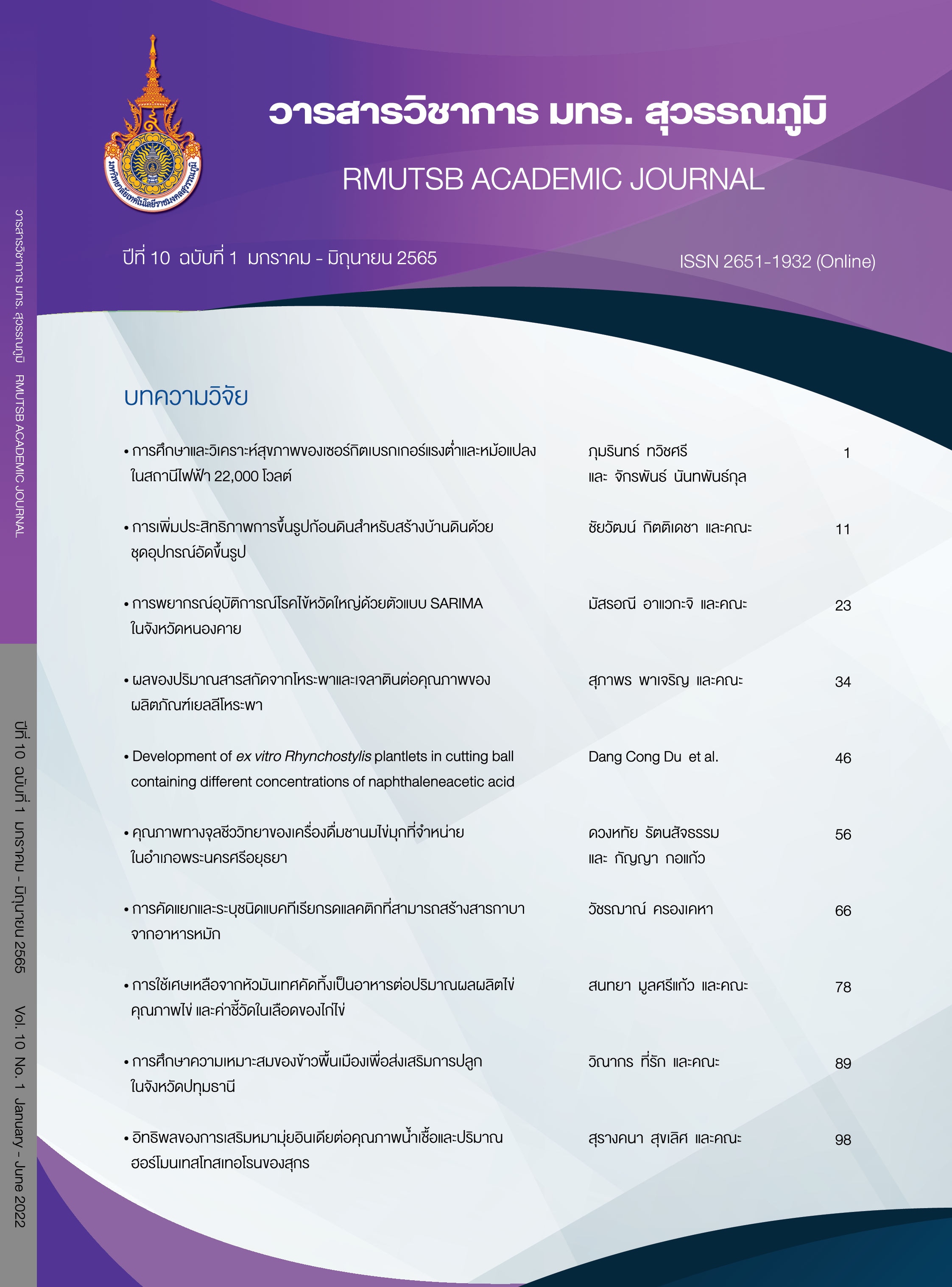Effect of Mucona dietary supplementation on semen quality and testosterone level in boars
Main Article Content
Abstract
Mucuna prureins (L.) DC has an important substance named Levodopa (L-dopa) which has effects on the central nervous system and reproductive system. Therefore, supplementation of M. prureins in animal diets may result in an increase of semen quality. Thus, this experiment aimed to study the influence of the M. prureins dietary supplementation on the reproductive efficiency, through the promotion of semen quality, of boars. Six Large White and 3-crossbred (Large White x Landrace x Duroc) boars with an average age of 8 months were used in this experiment. Animals were divided into 3 groups according to the levels of M. prureins supplementation which are 0, 70 and 140 mg/kg BW. The semen was collected twice per week for 12 weeks. The results showed that M. prureins supplementation at the levels of 70 and 140 mg/kg BW significantly increased semen volume and sperm concentration and reduced abnormal sperm morphology (p<0.05). In addition, testosterone concentration in serum was measured. It was found that boars supplemented with M. prureins had higher serum testosterone content than that were not supplemented (p<0.05). Therefore, dietary supplementation of M. prureins can improve reproductive performance and testosterone level in boars.
Article Details

This work is licensed under a Creative Commons Attribution-NonCommercial-NoDerivatives 4.0 International License.
Published manuscript are the rights of their original owners and RMUTSB Academic Journal. The manuscript content belongs to the authors' idea, it is not the opinion of the journal's committee and not the responsibility of Rajamangala University of Technology Suvarnabhumi
References
Concessao, P., Bairy, L. K., & Raghavendra, A. P. (2020). Effect of aqueous seed extract of Mucuna pruriens on arsenic-induced testicular toxicity in mice. Asian Pacific Journal of Reproduction, 9, 77-82.
Daramola, J. O. (2015). Effect of Mucuna (Mucuna pruriens) on spermiograms of West African dwarf bucks. Tropical and Subtropical Agroecosystems, 18, 145-150.
Deepthika, S. H. K., & Karunagoda K. P. K. R. (2021). Effect of Mucuna pruriens on sperm parameters with idiopathic infertility: A systematic review. International Ayurvedic Medical Journal, 3, 2802-2810.
Abraham, J. (2016). Effect of Mucuna puriens seeds on fertility of male Albino rats Rattus norvegicus. Journal of Pharmacy Research, 4(1), 233-236.
Islam, N., & Trainer, P. (1998). The hormone assessment of the infertile male. British Journal of Urology, 82, 69-75.
Lechowski, J., Kasprzyk, A., & Trawinska, B. (2018). Variability of semen in boars treated with vitamin C in food ration. Medycyna Weterynaryjna, 74(1), 48-53.
Lopez Rodriguez, A., Soom, A. V., Arsenakis, I., & Maes, D. (2017). Boar management and semen handling factors affect the quality of boar extended semen. Porcine Health Management, 3(15), 1-12.
Olamitibo, D. J., Adeoye, O. J., Amidu, S. T., Oluwafemi, A. E., Ayobami, I. O., Dayo, O. O., Daniel, O. F., Damilola, F. F., Semako, T. L., Onyinyechi, O. P., Abibat, S. O., Olorunjuda, S. O., & Damilola, S. O. (2017). Effects of mucuna seed extract on sperm functional integrities and seminal oxidative stress indices of vitrified goat semen. Journal of Agricultural Sciences, Belgrade, 62(2), 155-166.
Shukla, K. K., Mahdi, A. A., Ahmad, M. K., Jaiswar, S. P., Shankwar, S. N., & Tiwari, S. C. (2010). Mucuna pruriens reduces stress and improves the quality of semen in infertile men. Evid Based Complement Alternat Med, 7(1),137-144.
Shukla, K. K., Mahdi, A. A., Ahmad, M. K., Shankhwar, S. N., Rajender, S., & Jaiswar, S. P. (2009). Mucuna pruriens improves male fertility by its action on the hypothalamus-pituitary-gonadal axis. Fertility and Sterility, 92(6), 1934-1940.
Sriraman, V., Sairam, M. R., & Rao, A. J. (2003). Evaluation of relative role of LH and FSH in regulation of differentiation of Leydig cells using an ethane 1,2-dimethylsulfonate-treated adult rat model. Journal of Endocrinology, 176(1), 151-161.


